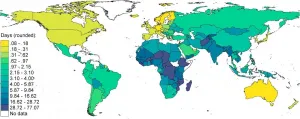INFORMATION:
Much of Mars' ancient water was buried in the planet's crust, not lost to space
2021-03-16
(Press-News.org) Several oceans' worth of ancient water may reside in minerals buried below Mars' surface, report researchers. The new study, based on observational data and modeling, shows that much of the red planet's initial water - up to 99% - was lost to irreversible crustal hydration, not escape to space. The findings help resolve the apparent contradictions between predicted atmospheric loss rates, the deuterium to hydrogen ratio (D/H) of present-day Mars and the geological estimates of how much water once covered the Martian surface. Ancient Mars was a wet planet - dry riverbeds and relic shorelines record a time when vast volumes of liquid water flowed across the surface. Today, very little of that water remains, mostly frozen in the planet's ice caps. Previous studies have assumed that the lost water escaped to space over several billion years, an assertion supported by the currently observed atmospheric D/H ratio. However, measurements of the current rate of atmospheric water loss are too low for atmospheric escape alone to explain all Martian water loss. Eva Scheller and colleagues show how large volumes of water could have instead become incorporated into minerals that were buried in the planet's crust. Using observational constraints from orbiting spacecraft, rovers and Martian meteorites, Scheller et al. developed a water budget and D/H model that considers atmospheric escape, volcanic degassing and crustal hydration through chemical weathering. By simulating Martian water loss through geological time and for a range of plausible conditions, the authors discovered that Mars had lost most of its water - between 40-95% - over the Noachian period (~4.1 - 3.7 billion years ago). The results suggest that between 30 and 99% of Mars' initial water was incorporated into minerals and buried in the planet's crust, with subsequent escape to space of the remainder accounting for the currently observed D/H ratio.
ELSE PRESS RELEASES FROM THIS DATE:
How do birds breathe better? Researchers' discovery will throw you for a loop
2021-03-16
Birds breathe with greater efficiency than humans due to the structure of their lungs--looped airways that facilitate air flows that go in one direction--a team of researchers has found through a series of lab experiments and simulations.
The findings will appear Fri., March 19 in the journal Physical Review Letters (to be posted between 10 and 11 a.m. EDT).
The study, conducted by researchers at New York University and the New Jersey Institute of Technology, also points to smarter ways to pump fluids and control flows in applications such as respiratory ventilators.
"Unlike the air flows deep in the branches of our lungs, which oscillate back and forth as we breathe in and out, the flow moves in a single direction in ...
Imposter syndrome is common among high achievers in med school
2021-03-16
PHILADELPHIA - Imposter syndrome is a considerable mental health challenge to many throughout higher education. It is often associated with depression, anxiety, low self-esteem and self-sabotage and other traits. Researchers at the Sidney Kimmel Medical College at Thomas Jefferson University wanted to learn to what extent incoming medical students displayed characteristics of imposter syndrome, and found that up to 87% of an incoming class reported a high or very high degree of imposter syndrome.
"Distress and mental health needs are critical issues among medical ...
Researchers use "swarmalation" to design active materials for self-regulating soft robots
2021-03-16
PITTSBURGH (March 16, 2021) ... During the swarming of birds or fish, each entity coordinates its location relative to the others, so that the swarm moves as one larger, coherent unit. Fireflies on the other hand coordinate their temporal behavior: within a group, they eventually all flash on and off at the same time and thus act as synchronized oscillators.
Few entities, however, coordinate both their spatial movements and inherent time clocks; the limited examples are termed "swarmalators"1, which simultaneously swarm in space and oscillate in time. Japanese tree frogs are exemplar swarmalators: each frog changes both its location and rate of croaking ...
Visa costs higher for people from poor countries
2021-03-16
How much do people have to pay for a travel permit to another country? A research team from Göttingen, Paris, Pisa and Florence has investigated the costs around the world. What they found revealed a picture of great inequality. People from poorer countries often pay many times what Europeans would pay. The results have been published in the journal Political Geography.
Dr Emanuel Deutschmann from the Institute of Sociology at the University of Göttingen, together with Professor Ettore Recchi, Dr Lorenzo Gabrielli and Nodira Kholmatova (from Sciences Po Paris, CNR-ISTI Pisa and EUI Florence respectively) compiled a new dataset on visa costs for travel between countries worldwide. The analysis shows that on average people ...
How pregnancy turns the stress response on its head
2021-03-16
COLUMBUS, Ohio - The link between psychological stress and physical health problems generally relates to a stress-induced immune response gone wild, with inflammation then causing damage to other systems in the body. It's a predictable cascade - except in pregnancy, research suggests.
Scientists exploring the negative effects of prenatal stress on offspring mental health set out to find the immune cells and microbes in stressed pregnant mice most likely to trigger inflammation in the fetal brain - the source for anxiety and other psychological problems identified in previous research.
Instead, the researchers found two simultaneous conditions ...
Keeping it cool: New approach to thermal protection in outdoor wearable electronics
2021-03-16
Wearable electronic devices like fitness trackers and biosensors, are very promising for healthcare applications and research. They can be used to measure relevant biosignals in real-time and send gathered data wirelessly, opening up new ways to study how our bodies react to different types of activities and exercise. However, most body-worn devices face a common enemy: heat.
Heat can accumulate in wearable devices owing to various reasons. Operation in close contact with the user's skin is one of them; this heat is said to come from internal sources. Conversely, when a device is worn outdoors, sunlight acts as a massive external source of heat. These sources combined can easily raise the temperature ...
Research shows how mutations in SARS-CoV-2 allow the virus to dodge immune defenses
2021-03-16
The vast majority of people infected with SARS-CoV-2 clear the virus, but those with compromised immunity--such as individuals receiving immune-suppressive drugs for autoimmune diseases--can become chronically infected. As a result, their weakened immune defenses continue to attack the virus without being able to eradicate it fully.
This physiological tug-of-war between human host and pathogen offers a valuable opportunity to understand how SARS-CoV-2 can survive under immune pressure and adapt to it.
Now, a new study led by Harvard Medical School scientists offers a look into this interplay, shedding light on the ways in which ...
FSU researchers enhance quantum machine learning algorithms
2021-03-16
A Florida State University professor's research could help quantum computing fulfill its promise as a powerful computational tool.
William Oates, the Cummins Inc. Professor in Mechanical Engineering and chair of the Department of Mechanical Engineering at the FAMU-FSU College of Engineering, and postdoctoral researcher Guanglei Xu found a way to automatically infer parameters used in an important quantum Boltzmann machine algorithm for machine learning applications.
Their findings were published in Scientific Reports.
The work could help build artificial neural networks ...
Photocatalytic efficiency in photocatalysis found to be site sensitive
2021-03-16
Prof. HUANG Weixin and ZHANG Qun from University of Science and Technology of China (USTC) of the Chinese Academy of Sciences (CAS), together with domestic collaborators, probed into the photocatalytic oxidation of methanol on various anatase TiO2 nanocrystals. The results were published on Angewandte Chemie International Edition.
Semiconductor-based photocatalysis has attracted extensive attention since its discovery, owing to its environmentally friendly production of chemical fuel utilizing solar energy.
A photocatalytic reaction consists of light absorption and charge generation within photocatalysts, ...
Practical nanozymes discovered to fight antimicrobial resistance
2021-03-16
Nanozymes, a group of inorganic catalysis-efficient particles, have been proposed as promising antimicrobials against bacteria. They are efficient in killing bacteria, thanks to their production of reactive oxygen species (ROS).
Despite this advantage, nanozymes are generally toxic to both bacteria and mammalian cells, that is, they are also toxic to our own cells. This is mainly because of the intrinsic inability of ROS to distinguish bacteria from mammalian cells.
In a study published in Nature Communications, the research team led by XIONG Yujie and YANG Lihua from University of Science and Technology (USTC) of the Chinese Academy of Sciences (CAS) proposed a novel method to construct efficient-while-little-toxic nanozymes.
The researchers showed that nanozymes ...


